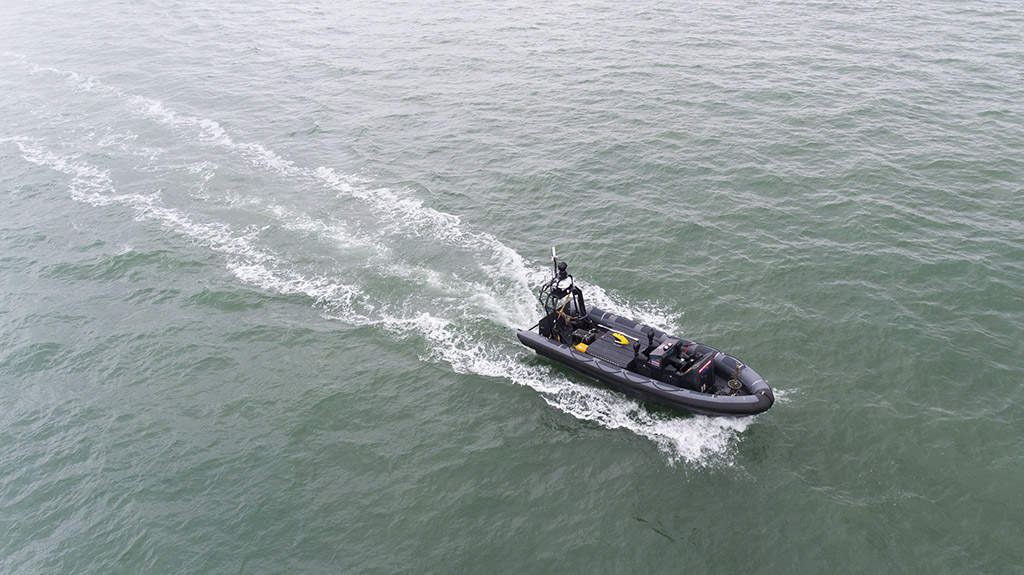

Katie Woodward: Please could you tell us about the technology you are trialling at Unmanned Warrior – its capabilities, features, applications.
BAE Systems: We will have a number of technologies on display at Unmanned Warrior this year. Our PAC950 rigid inflatable boat (RIB) developed in collaboration with ASV Limited will take to the water in the Hebrides part of the event. The RIB can be controlled autonomously and is capable of 45 knots.
MAPLE (Maritime Autonomous Platform Exploitation), a transportable command and control centre capable of integrating unmanned systems from multiple suppliers, will be used to control the RIB.
A key feature of MAPLE is that it minimises the number of screens and controls needed to conduct missions which makes the whole system highly efficient whilst minimising the risk of human error.
MAPLE is the product of a Dstl contract to create a maritime mission planning and command and control system for unmanned vehicles, and is being led by a consortium of BAE Systems, QinetiQ, Seabyte and Thales.
ACER is the demonstration system of MAPLE and is hosted on our shared infrastructure (SI). It is made up of our combat management system (CMS); a mission management system (MMS) including our goal-based mission planner (GBMP) and digital chart service; a universal video management system; and our air planning tool, combined arms gateway environment (CAgE).
Our new technologies will be vital in coordinating this complex exercise which will inform the Royal Navy’s planning for future capabilities.
KW: How important is autonomy for the maritime defence industry?
BAE: In line with evolving threats the requirements for defence are continually changing, with this in mind we are constantly looking at ways to drive technological advances within the maritime defence industry and autonomy is just one aspect of this.
There is a great deal of potential in autonomy. A ship sailing in dangerous waters puts its crew at risk, whereas an unmanned vehicle controlled from the safety of an operations room can take that person out of harm’s way, for example.
KW: What developments can we expect over the next few years in unmanned technologies?
BAE: The majority of systems demonstrated in the UK have been remotely piloted, or have simple autonomous behaviour such as navigating from waypoint to waypoint.
We can expect that future systems will be provided with comprehensive sensors to determine the local environment and allow vehicles much more autonomy – for example, unmanned surface vehicles may sense other vehicles and steer a course around them; or determine sea bottom obstacles, changing tide conditions, and shifting seabed topology to steer a safe course and meet the objectives of the mission.
KW: Are you working on any future autonomous systems?
BAE: We have developed an advanced system upgrade for our PAC950 RIBs called Jekyll, which provides versatile unmanned capability and allows vital tasks such as high speed reconnaissance, remote surveillance, and extended duration missions. The main advantage is that it keeps crews safely out of harm’s way.
We are also a key partner in programmes within the mine hunting domain. For mine hunting, and the implementation of counter measures, it is vital to take both people and unmanned ships from a danger area. Unmanned systems can provide the search, identification, and destruction of mine fields quicker and safer than today’s technology.
KW: What do you hope to gain from participating in Unmanned Warrior 2016?
BAE: Unmanned Warrior gives us the perfect opportunity to demonstrate how the command and control of unmanned vehicles can be integrated seamlessly into the existing shipborne and land-based infrastructures.
The real challenge around the introduction of autonomy is how a mix of manned and unmanned systems is managed and Unmanned Warrior 2016 gives us the opportunity to demonstrate how the technology that we’ve been developing enables this to happen.



